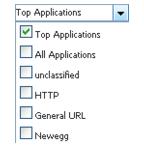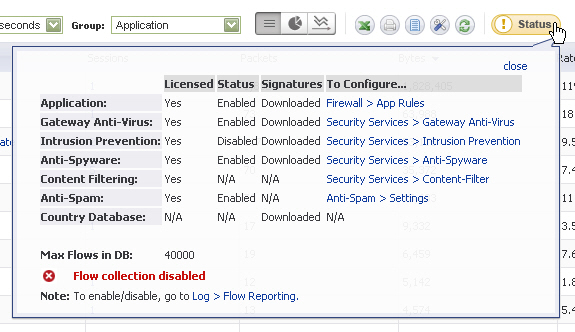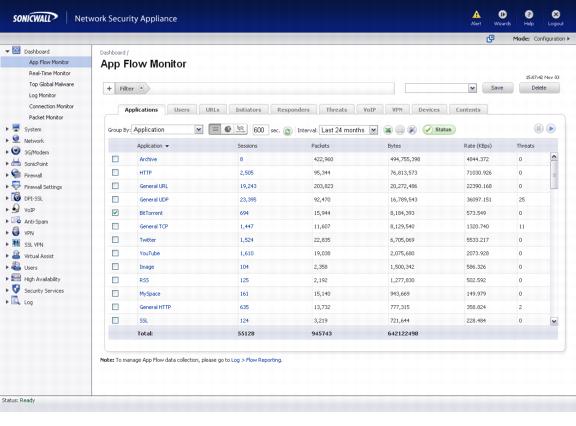RealTimeMonitor
Real-Time Monitor
The Real-Time Monitor provides administrators an inclusive, multi-functional display with information about applications, bandwidth usage, multi-core monitoring, and memory usage. The Real-Time Monitor comprises of a toolbar and four real-time data flows which consist of Applications, Ingress and Egress Bandwidth, Multi-Core Monitor, and Memory Usage.
This section contains the following subsections:
Using the Toolbar
The Real-Time Monitor Toolbar contains features to specify the refresh rate, export details, configure color palettes, change the amount of data displayed, and pause or play the data flow. Changes made to the toolbar apply across all the data flows.
|
Determines the frequency at which data is refreshed. A numerical integer between 1 to 10 seconds is required. |
|||||||||||
|
Exports the data flow into a comma separated variable (.csv) file. The default file name is sonicflow.csv. |
|||||||||||
|
Allows for customization of the color palette for the Application Chart and Bandwidth Chart. To customize the Color Palette:
If a gradient is desired, select the Use Gradient box located below the text fields. |
|||||||||||
|
Displays the current time in 24-hour format (hh:mm:ss), and the current date in Month/Day format. |
|||||||||||
|
Freezes the data flow. The time and date will also freeze. The Pause button will appear gray if the data flow has been frozen. |
|||||||||||
|
Unfreezes the data flow. The time and date will refresh as soon as the data flow is updated. |
Real-Time Application Flow
The Applications data flow provides a visual representation of the current applications accessing the network.
Options are available to Lock/Unlock, Display, Scale, and View the Application interface.
|
Application Display |
Specifies the applications displayed in the Application Flow Chart. A drop menu allows the administrator to specify Top Applications, All Applications, unclassified, or individual applications. If desired, multiple applications can be selected by clicking more than one check box. |
|
|
Allows for Auto Y-Scaling or customized scaling of the Application Flow Chart. The values for customized scaling must be a numeric integer. Specifying a unit is optional. If a unit is desired, these are the available options: If a custom scale of 100Kbps is desired, then “100K” should be entered. The numeric integer 100 is entered followed by the unit K. |
||
Available Formats
Administrators are able to view the Application flow charts in a bar graph format or flow chart format. The bar graph format displays applications individually, allowing administrators to compare applications. In this graph, the x-axis displays the name of the applications. The y-axis displays the amount of traffic for each application.
The flow chart format displays over lapping application data. In this graph, the x-axis displays the current time and the y-axis displays the traffic for each application.
Ingress and Egress Bandwidth Flow
The Ingress and Egress Bandwidth data flow provides a visual representation of incoming and outgoing bandwidth traffic. The current percentage of total bandwidth used, average flow of bandwidth traffic, and the minimum and maximum amount of traffic that has gone through each interface is available in the display.
Options are available to customize the Display, Scale, and View of the Ingress and Egress Bandwidth interface.
|
Interface Rate Display |
Specifies which Interfaces are displayed in the Bandwidth Flow Chart. A drop menu provides the administrator with options to specify All Interfaces Rate, All Interfaces, and individual interfaces. The individual interfaces vary depending on the number of interfaces on the administrator’s network. Multiple interfaces can be selected if desired. |
|
|
Allows for Auto Y-Scaling or custom scaling of the Bandwidth Flow Chart. The values for customized scaling must be a numeric integer. Specifying a unit is optional. If a unit is desired, four options are available: If a custom scale of 100Kbps is desired, then “100K” should be entered. The numeric integer 100 is entered followed by the unit K. |
||
|
Bar Graph Format |
Displays the real-time Bandwidth data in a bar graph format. |
|
|
Flow Chart Format |
Displays the real-time Bandwidth data in a flow chart format. |
Formats
Administrators are able to view the Ingress and Egress Bandwidth flow chart in a bar graph format or flow chart format.
The bar graph format displays data pertaining to individual interfaces in a bar graph; allowing administrators to compare individual Bandwidth Interfaces. In this graph, the x-axis denotes the Interfaces whereas the y-axis denotes the Ingress and Egress Bandwidth traffic.
The flow chart format overlaps the Bandwidth Interfaces; allowing administrators to view all of the Ingress and Egress Bandwidth traffic as it occurs. The x-axis displays the current time and the y-axis displays the Ingress and Egress Bandwidth traffic.
Tooltips
Rolling over the interfaces provides tooltips with information about the interface assigned zone, IP address, and current port status.
The Multi-Core Monitor Flow
The Multi-Core Monitor provides the administrator with information on the CPU usage of their appliance. The graph shows current percentage of utilization, average percentage used, minimum percentage used, and maximum percentage used.
Scale, and View are options available to customize the Multi-Core Monitor interface.
|
Aggregate Display |
Specifies which Cores are displayed in the Multi- Core Monitor Flow Chart. A drop menu allowing the administrator to specify Current (Aggregate), Average (Aggregate), and individual Cores. The individual Cores vary depending on the number of Cores available. Multiple Cores can be selected if desired. |
|
|
Allows for Auto Y-Scaling or customized scaling of the Application Flow Chart. The values for customized scaling must be a numeric integer. Specifying a unit is optional. If a unit is desired, the four available options include: If a custom scale of 100 percent is desired, then “100%” should be entered. The numeric integer 100 is entered followed by the unit K. |
||
|
Bar Graph Format |
Displays the Multi-Core Monitor data in a bar graph format. |
|
|
Flow Chart Format |
Displays the Multi-Core Monitor data in a flow chart format. |
Formats
Administrators are able to view the Multi-Core Monitor flow chart in a bar graph format or flow chart format.
The bar graph format displays data pertaining to individual Cores in a bar graph. In this graph the x-axis displays the Cores where the y-axis displays the percentage of CPU used.
The flow chart format overlaps the Multi-Core Monitor data. The x-axis displays the current time and the y-axis displays the percentage of CPU used.
Memory Usage Flow
The Memory Usage data flow provides the administrator a visual representation of available memory for usage, total used memory, and memory used by the database. The x-axis units display the memory size. The y-axis displays the available memory, used memory, and database memory.
Enabling Flow Collection
The realtime application monitoring features rely on flow the collection mechanism in order to collect and display data. Before using App Flow Monitor or the “applications” chart in the Real-Time Monitor, you must first enable and configure the flow collection feature.
Prior to enabling the Flow Collection feature, your status button may display a warning.
|
|
Navigate to the Log > Flow Reporting page in the SonicOS management interface. |
|
|
Select the Enable Flow Reporting and Visualization checkbox. |
|
|
Click the Accept button to save your changes and enable the feature. |
|
|
Navigate to the Network > Interfaces page. |
|
|
In the Advanced tab, ensure that the Enable flow reporting checkbox is selected. |
|
|
Click the OK button to save your changes. |
|
|
|
For more detailed information on configuring Flow Reporting settings, refer to the SonicWALL NetFlow Feature Module . |
Using Filtering Options
Using filtering options allow administrators to reduce the amount of data seen in the App Flow Monitor. By doing so, administrators can focus on points of interest without distraction from other applications. To use the Filtering Options:
|
|
Log into the SonicWALL Network Security Appliance and go to Dashboard > App Flow Monitor > Applications Tab . Then select the check boxes of the applications you wish to add to the filter. In this case, BitTorrent is selected. |
|
|
Click Filter View to add BitTorrent to the filter. |
|
|
Once the application is added to the filter, only BitTorrent is visible in the Applications tab. |
More information about Users, peer connectivity, and packets sent are visible in the App Flow Monitor tabs. The Users using BitTorrent are visible in the Users tab. The IP Addresses of these users are visible in the Initiators tab. The IP Addresses of the connected peers who are sharing packets are visible in the Responders Tab.













